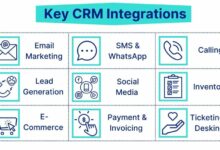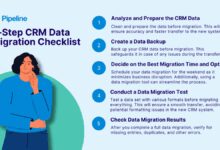Salesforce Integration Services: 7 Powerful Benefits You Can’t Ignore
In today’s fast-evolving digital landscape, businesses are turning to Salesforce integration services to unlock seamless data flow, boost productivity, and drive smarter decisions—all without the chaos of siloed systems.
What Are Salesforce Integration Services?

Salesforce integration services refer to the process of connecting Salesforce, the world’s leading Customer Relationship Management (CRM) platform, with other software systems, databases, or applications used across an organization. These integrations ensure that data flows smoothly between platforms—such as ERP systems, marketing automation tools, customer support software, and e-commerce platforms—without requiring manual entry or risking data inconsistencies.
How Salesforce Integration Works
At its core, Salesforce integration involves using APIs (Application Programming Interfaces), middleware platforms, or integration tools to establish communication between Salesforce and external systems. These connections can be real-time or batch-based, depending on business needs. For example, when a sales rep updates a customer’s contact information in Salesforce, that change can automatically reflect in the company’s email marketing tool or accounting software.
- APIs like REST and SOAP enable secure, programmatic access to Salesforce data.
- Middlewares such as MuleSoft (a Salesforce-owned platform) act as integration hubs.
- Pre-built connectors simplify integration with popular platforms like Shopify, Slack, or Microsoft Dynamics.
“Integration is no longer a luxury—it’s a necessity for businesses aiming to deliver personalized customer experiences at scale.” — Salesforce Industry Report, 2023
Types of Salesforce Integrations
There are several types of Salesforce integration services tailored to different business functions:
- Bi-directional Sync: Data flows both ways between Salesforce and another system (e.g., syncing leads from a marketing automation tool into Salesforce and updating campaign status back).
- Unidirectional Sync: Data moves in one direction only (e.g., exporting Salesforce reports to a BI tool).
- Event-Driven Integration: Triggers actions based on specific events (e.g., creating a support ticket in Zendesk when a case is logged in Salesforce).
- Batch Integration: Processes large volumes of data at scheduled intervals (e.g., nightly sync of inventory levels from ERP to Salesforce).
Each type serves a unique purpose and can be customized based on organizational workflows, security requirements, and scalability needs.
Why Salesforce Integration Services Are Essential for Modern Businesses
In an era where data drives decisions, disconnected systems create inefficiencies, increase errors, and hinder growth. Salesforce integration services bridge these gaps by ensuring that every department—from sales and marketing to finance and customer service—operates on accurate, up-to-date information.
Eliminating Data Silos
Data silos occur when information is trapped within isolated departments or systems. For example, marketing might use HubSpot, finance relies on QuickBooks, and customer support runs on Zendesk—none of which communicate with Salesforce. This leads to duplicated efforts, inconsistent customer records, and missed opportunities.
By implementing Salesforce integration services, companies can unify their data ecosystem. When a new lead enters Salesforce from a web form, it can automatically trigger a welcome email via Mailchimp, create a task in Asana, and notify the sales team via Slack—all without human intervention.
Improving Operational Efficiency
Manual data entry is not only time-consuming but also prone to errors. According to a study by IBM, poor data quality costs the U.S. economy over $3 trillion annually. Salesforce integration services eliminate redundant tasks by automating data transfer across platforms.
- Sales teams spend less time updating records and more time closing deals.
- Customer service agents get instant access to complete customer histories.
- Marketing teams can segment audiences accurately using real-time behavioral data.
Automation through integration reduces operational overhead and allows employees to focus on high-value activities.
Top 7 Benefits of Salesforce Integration Services
The advantages of leveraging Salesforce integration services extend far beyond simple data syncing. Here are seven powerful benefits that can transform your business operations:
1. Enhanced Customer Experience
Customers expect personalized interactions across every touchpoint. With integrated systems, Salesforce becomes a single source of truth for customer data. Whether a client calls support, chats online, or interacts via email, agents have full visibility into past purchases, preferences, and communication history.
For instance, integrating Salesforce with a live chat platform like Intercom allows support reps to see real-time visitor behavior and past interactions before initiating a conversation. This level of personalization boosts satisfaction and loyalty.
2. Real-Time Data Access Across Departments
When sales, marketing, and service teams work from the same updated dataset, collaboration improves dramatically. A marketing campaign’s performance can be instantly analyzed in Salesforce, allowing sales to prioritize hot leads. Similarly, customer feedback collected in Service Cloud can inform product development teams.
Real-time integration ensures that decisions are based on current data rather than outdated spreadsheets or stale reports.
3. Increased Sales Productivity
Salesforce integration services empower sales teams with tools that automate routine tasks. Integrating Salesforce with calendar apps like Google Calendar or Outlook ensures automatic logging of meetings. Email integration with Gmail or Microsoft 365 enables one-click logging of sent emails and attachments directly into Salesforce records.
Tools like DocuSign can be integrated to allow contract signing within Salesforce, reducing turnaround time from days to minutes. According to Salesforce, companies using integrated e-signature tools close deals 40% faster on average.
4. Streamlined Marketing Automation
Marketing teams benefit immensely from Salesforce integration services. Platforms like Marketo, Pardot (a Salesforce product), and HubSpot can sync lead data bidirectionally with Salesforce. When a prospect downloads a whitepaper, their engagement score updates in real time, and Salesforce assigns them to the right sales rep based on predefined rules.
This closed-loop marketing approach enables precise ROI measurement—marketers can track which campaigns generate the most qualified leads and revenue.
5. Accurate Forecasting and Reporting
Integrated data provides a holistic view of business performance. Finance teams can pull revenue forecasts directly from Salesforce into financial planning tools like Adaptive Insights or NetSuite. Executives gain access to dashboards that combine sales pipeline data, marketing spend, and customer service metrics.
With tools like Tableau (acquired by Salesforce), businesses can visualize complex datasets and uncover trends that would otherwise go unnoticed.
6. Scalability and Future-Proofing
As businesses grow, so do their technology stacks. Salesforce integration services make it easier to adopt new tools without disrupting existing workflows. Whether adding a new HR system, expanding into international markets, or launching a mobile app, integrations ensure smooth data flow across evolving architectures.
salesforce integration services – Salesforce integration services menjadi aspek penting yang dibahas di sini.
Using scalable integration platforms like MuleSoft or Dell Boomi allows organizations to build reusable integration templates, reducing development time for future projects.
7. Improved Compliance and Security
Data governance is a top concern for enterprises. Salesforce integration services support compliance with regulations like GDPR, HIPAA, and CCPA by ensuring data is handled securely and audit trails are maintained.
Integration platforms offer features like encryption, role-based access control, and logging capabilities. For example, when integrating Salesforce with a payment processor like Stripe, sensitive financial data can be tokenized and stored securely, minimizing exposure.
Common Salesforce Integration Use Cases
Salesforce integration services are applied across various industries and departments. Below are some of the most common and impactful use cases:
Sales and CRM Synchronization
Integrating Salesforce with external CRMs or sales tools ensures that all customer interactions are captured in one place. For example, a company using both Salesforce and LinkedIn Sales Navigator can sync prospect profiles and outreach activities directly into Salesforce, enabling better tracking and follow-up.
This integration helps sales reps prioritize outreach based on engagement levels and build stronger relationships through timely, relevant communication.
Marketing Platform Integration
Connecting Salesforce with marketing automation platforms enables seamless lead management. When a visitor fills out a form on a website powered by WordPress or Drupal, the data is automatically pushed to Salesforce and tagged with campaign source information.
Marketo and Pardot are two popular platforms that integrate deeply with Salesforce. They allow marketers to score leads, nurture them through email workflows, and pass them to sales when they reach a certain threshold—all while maintaining full visibility in Salesforce.
ERP and Financial System Integration
Integrating Salesforce with ERP systems like SAP, Oracle NetSuite, or Microsoft Dynamics 365 ensures alignment between sales and finance. When a deal is closed in Salesforce, the order details can be automatically sent to the ERP for fulfillment, invoicing, and inventory updates.
This eliminates discrepancies between sales forecasts and actual revenue, improves cash flow visibility, and reduces order processing time. According to a Gartner report, companies with integrated CRM and ERP systems experience a 25% reduction in order-to-cash cycle times.
Choosing the Right Salesforce Integration Tools
Selecting the appropriate tools for Salesforce integration services depends on several factors, including technical expertise, budget, scalability needs, and the complexity of the integration landscape.
MuleSoft: The Enterprise Integration Powerhouse
Acquired by Salesforce in 2018, MuleSoft is one of the most robust integration platforms available. It offers Anypoint Platform, which supports API-led connectivity across cloud and on-premise systems.
MuleSoft excels in complex, large-scale integrations. For example, a global bank might use MuleSoft to connect Salesforce with legacy core banking systems, ensuring secure and reliable data exchange. Its visual design interface allows developers to build integrations quickly, while its reusable assets reduce long-term maintenance costs.
Learn more about MuleSoft’s capabilities at mulesoft.com.
Dell Boomi: No-Code Simplicity
Dell Boomi is a cloud-native integration platform that emphasizes ease of use. With its drag-and-drop interface, even non-technical users can create integrations between Salesforce and other applications.
Boomi supports over 1,000 pre-built connectors, making it ideal for mid-sized businesses looking to integrate quickly. For example, a retail company could use Boomi to sync Salesforce customer data with Shopify for personalized promotions and inventory updates.
Explore Boomi’s integration solutions at boomi.com.
Zapier: Lightweight Automation for Small Teams
For small businesses or departments with limited IT resources, Zapier offers a simple way to automate workflows between Salesforce and hundreds of apps like Trello, Slack, and Google Sheets.
A marketing team might set up a “Zap” that automatically creates a Salesforce lead whenever someone signs up for a webinar via Eventbrite. While Zapier lacks the depth of enterprise tools, it’s perfect for lightweight, rule-based automations.
Visit zapier.com to explore ready-to-use Salesforce integrations.
Best Practices for Implementing Salesforce Integration Services
Successful integration isn’t just about choosing the right tool—it’s about planning, execution, and ongoing management. Follow these best practices to ensure a smooth and sustainable integration process.
Define Clear Business Objectives
Before starting any integration project, identify the specific goals you want to achieve. Are you trying to reduce manual data entry? Improve lead conversion rates? Enhance customer service response times?
salesforce integration services – Salesforce integration services menjadi aspek penting yang dibahas di sini.
Clear objectives help prioritize integration efforts and measure success. For example, if the goal is to improve sales productivity, focus on integrating Salesforce with email, calendar, and document signing tools.
Map Data Flows and Dependencies
Create a detailed map of how data moves between systems. Identify source systems, target systems, transformation rules, and synchronization frequency.
This mapping exercise helps uncover potential bottlenecks, data conflicts, or security risks. For instance, if both Salesforce and an external HR system contain employee records, decide which system is the “system of record” to avoid duplication.
Ensure Data Quality and Governance
Poor data quality undermines integration efforts. Implement data validation rules, deduplication processes, and standardization protocols before syncing systems.
- Use Salesforce’s Data Quality tools to clean and enrich records.
- Establish naming conventions and field requirements across platforms.
- Assign data stewards responsible for maintaining accuracy.
Test Thoroughly Before Go-Live
Always conduct rigorous testing in a sandbox environment before deploying integrations in production. Test various scenarios, including edge cases like failed API calls or network outages.
Monitor performance metrics such as latency, error rates, and data throughput. Use logging and monitoring tools to detect issues early.
Plan for Ongoing Maintenance
Integrations require regular updates due to API changes, security patches, or business process evolution. Establish a maintenance schedule and assign ownership to an internal team or managed service provider.
Document all integration configurations and workflows to ensure continuity during staff transitions.
Challenges and Solutions in Salesforce Integration Services
While the benefits are substantial, implementing Salesforce integration services comes with challenges. Understanding these obstacles and how to overcome them is crucial for long-term success.
Data Security and Compliance Risks
Connecting multiple systems increases the attack surface for cyber threats. Sensitive customer data flowing between Salesforce and third-party apps must be protected.
Solution: Use secure authentication methods like OAuth 2.0, encrypt data in transit and at rest, and conduct regular security audits. Choose integration platforms that comply with industry standards like SOC 2, ISO 27001, and GDPR.
API Limitations and Rate Throttling
Salesforce imposes API request limits based on edition and license type. Exceeding these limits can cause integration failures or performance degradation.
Solution: Optimize API usage by batching requests, caching responses, and scheduling syncs during off-peak hours. Monitor API usage through Salesforce’s Health Check dashboard and upgrade licenses if necessary.
Complexity of Legacy System Integration
Many organizations still rely on legacy systems that lack modern APIs or support for cloud integration.
Solution: Use middleware platforms like MuleSoft or IBM App Connect to act as a bridge between Salesforce and legacy databases. These tools can parse flat files, connect via JDBC/ODBC, or use ETL (Extract, Transform, Load) processes to modernize data flow.
Future Trends in Salesforce Integration Services
The landscape of Salesforce integration services is rapidly evolving, driven by advancements in AI, low-code platforms, and real-time data processing. Staying ahead of these trends ensures your business remains agile and competitive.
AI-Powered Integration
Salesforce Einstein AI is already transforming how data is used within the platform. In the near future, AI will play a bigger role in integration itself—automatically suggesting field mappings, predicting integration failures, and optimizing data flows based on usage patterns.
For example, Einstein could detect that a particular integration runs slowly during peak hours and recommend rescheduling it to off-peak times.
Low-Code and No-Code Dominance
The demand for faster integration deployment is fueling the rise of low-code and no-code platforms. Tools like Salesforce Flow, MuleSoft Composer, and Boomi Flow allow business users to build integrations without writing code.
This democratization of integration empowers non-technical teams to solve their own data challenges while reducing IT backlogs.
Event-Driven and Real-Time Architectures
As customer expectations for instant responses grow, businesses are shifting from batch processing to real-time, event-driven integration models. Instead of syncing data every hour, systems react instantly to events like a new order, a support ticket update, or a website visit.
Platforms like Salesforce Platform Events and Kafka enable this real-time communication, creating a more responsive and dynamic ecosystem.
salesforce integration services – Salesforce integration services menjadi aspek penting yang dibahas di sini.
How to Get Started with Salesforce Integration Services
Beginning your integration journey doesn’t have to be overwhelming. Follow this step-by-step guide to launch your first Salesforce integration successfully.
Assess Your Current Tech Stack
Take inventory of all the software systems your organization uses. Categorize them by function—CRM, marketing, finance, HR, etc.—and identify which ones need to communicate with Salesforce.
Ask questions like: Which systems contain customer data? Where are manual processes slowing us down? What integrations would deliver the highest ROI?
Prioritize Integration Projects
Not all integrations are equally urgent. Use a prioritization matrix based on impact and effort. Start with high-impact, low-effort integrations—such as connecting Salesforce with Gmail or Slack—to demonstrate quick wins.
Once initial successes are achieved, scale up to more complex projects like ERP integration.
Choose the Right Partner or Platform
Decide whether to build integrations in-house, use a third-party tool, or hire a certified Salesforce integration partner. For complex enterprise needs, partnering with a Salesforce consulting firm like Accenture, Deloitte, or a specialized boutique agency can ensure best practices and faster delivery.
Review case studies, certifications, and client testimonials before making a decision.
Train Users and Monitor Performance
Even the best integration fails if users don’t understand how to leverage it. Provide training sessions, create user guides, and set up feedback loops to address concerns.
Use monitoring tools to track integration health—look for metrics like sync success rate, latency, and error logs. Set up alerts for anomalies to prevent data loss.
What are Salesforce integration services?
Salesforce integration services involve connecting Salesforce with other business applications—like ERP, marketing automation, or customer support tools—to enable seamless data exchange and improve operational efficiency.
What are the most common tools for Salesforce integration?
Popular tools include MuleSoft (enterprise-grade), Dell Boomi (no-code), Zapier (lightweight automation), and native options like Salesforce Flow and Platform Events.
How do Salesforce integrations improve customer experience?
By providing a unified view of the customer across all touchpoints, integrations enable personalized interactions, faster response times, and consistent service delivery.
Are Salesforce integrations secure?
Yes, when implemented correctly using secure protocols like OAuth, encryption, and compliance with data protection regulations. Choosing trusted integration platforms enhances security.
Can non-technical users set up Salesforce integrations?
Yes, with no-code platforms like Zapier, MuleSoft Composer, or Salesforce Flow, business users can create simple integrations without coding knowledge.
Salesforce integration services are no longer optional—they are a strategic imperative for businesses aiming to thrive in a data-driven world. From eliminating silos and boosting productivity to enhancing customer experiences and ensuring compliance, the benefits are profound and measurable. By leveraging the right tools, following best practices, and staying ahead of emerging trends, organizations can unlock the full potential of their Salesforce investment and build a truly connected enterprise.
salesforce integration services – Salesforce integration services menjadi aspek penting yang dibahas di sini.
Further Reading:



